2004 CHEVROLET SILVERADO jump start
[x] Cancel search: jump startPage 397 of 584

Service............................................................5-3
Doing Your Own Service Work.........................5-4
Adding Equipment to the Outside of
Your Vehicle..............................................5-5
Fuel................................................................5-5
Gasoline Octane............................................5-5
Gasoline Speci�cations....................................5-6
California Fuel...............................................5-6
Additives.......................................................5-7
Fuel E-85 (85% Ethanol).................................5-8
Fuels in Foreign Countries...............................5-9
Filling Your Tank............................................5-9
Filling a Portable Fuel Container.....................5-11
Checking Things Under the Hood....................5-12
Hood Release..............................................5-12
Engine Compartment Overview.......................5-14
Engine Oil...................................................5-20
Engine Air Cleaner/Filter................................5-25
Automatic Transmission Fluid
(Except Allison Transmission
®) ....................5-27
Automatic Transmission Fluid
(Allison Transmission
®) ...............................5-30
Manual Transmission Fluid.............................5-33
Hydraulic Clutch...........................................5-34Engine Coolant.............................................5-35
Coolant Surge Tank Pressure Cap..................5-38
Engine Overheating.......................................5-38
Cooling System............................................5-41
Engine Fan Noise.........................................5-46
Power Steering Fluid.....................................5-46
Windshield Washer Fluid................................5-47
Brakes........................................................5-49
Battery........................................................5-52
Jump Starting...............................................5-53
All-Wheel Drive..............................................5-58
Rear Axle.......................................................5-59
Four-Wheel Drive............................................5-60
Noise Control System.....................................5-61
Tampering with Noise Control System
Prohibited.................................................5-61
Bulb Replacement..........................................5-63
Halogen Bulbs..............................................5-63
Headlamps..................................................5-63
Front Turn Signal, Sidemarker and
Daytime Running Lamps.............................5-65
Roof Marker Lamps......................................5-66
Center High-Mounted Stoplamp (CHMSL)
and Cargo Lamp.......................................5-68
Section 5 Service and Appearance Care
5-1
Page 411 of 584
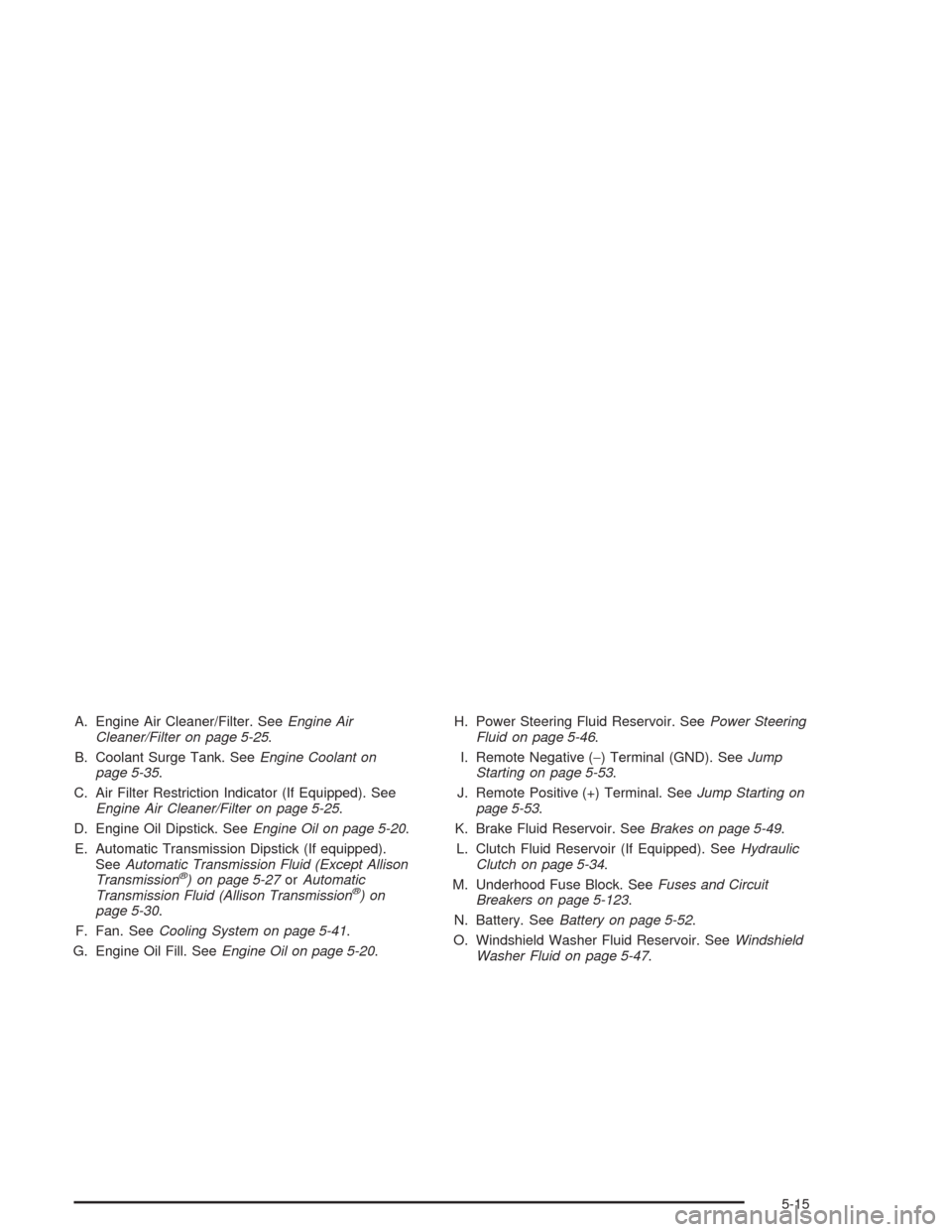
A. Engine Air Cleaner/Filter. SeeEngine Air
Cleaner/Filter on page 5-25.
B. Coolant Surge Tank. SeeEngine Coolant on
page 5-35.
C. Air Filter Restriction Indicator (If Equipped). See
Engine Air Cleaner/Filter on page 5-25.
D. Engine Oil Dipstick. SeeEngine Oil on page 5-20.
E. Automatic Transmission Dipstick (If equipped).
SeeAutomatic Transmission Fluid (Except Allison
Transmission
®) on page 5-27orAutomatic
Transmission Fluid (Allison Transmission®)on
page 5-30.
F. Fan. SeeCooling System on page 5-41.
G. Engine Oil Fill. SeeEngine Oil on page 5-20.H. Power Steering Fluid Reservoir. SeePower Steering
Fluid on page 5-46.
I. Remote Negative (−) Terminal (GND). SeeJump
Starting on page 5-53.
J. Remote Positive (+) Terminal. SeeJump Starting on
page 5-53.
K. Brake Fluid Reservoir. SeeBrakes on page 5-49.
L. Clutch Fluid Reservoir (If Equipped). SeeHydraulic
Clutch on page 5-34.
M. Underhood Fuse Block. SeeFuses and Circuit
Breakers on page 5-123.
N. Battery. SeeBattery on page 5-52.
O. Windshield Washer Fluid Reservoir. SeeWindshield
Washer Fluid on page 5-47.
5-15
Page 413 of 584
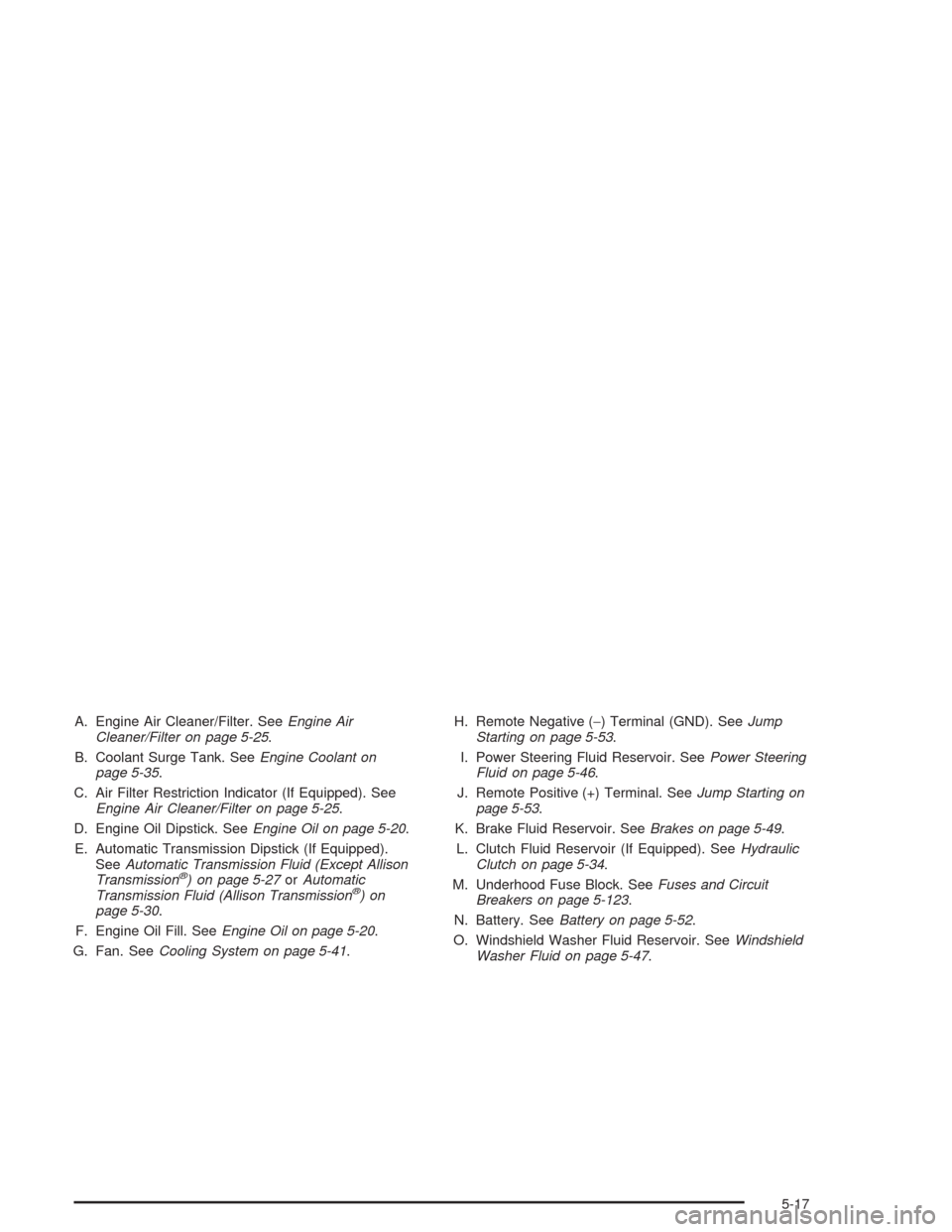
A. Engine Air Cleaner/Filter. SeeEngine Air
Cleaner/Filter on page 5-25.
B. Coolant Surge Tank. SeeEngine Coolant on
page 5-35.
C. Air Filter Restriction Indicator (If Equipped). See
Engine Air Cleaner/Filter on page 5-25.
D. Engine Oil Dipstick. SeeEngine Oil on page 5-20.
E. Automatic Transmission Dipstick (If Equipped).
SeeAutomatic Transmission Fluid (Except Allison
Transmission
®) on page 5-27orAutomatic
Transmission Fluid (Allison Transmission®)on
page 5-30.
F. Engine Oil Fill. SeeEngine Oil on page 5-20.
G. Fan. SeeCooling System on page 5-41.H. Remote Negative (−) Terminal (GND). SeeJump
Starting on page 5-53.
I. Power Steering Fluid Reservoir. SeePower Steering
Fluid on page 5-46.
J. Remote Positive (+) Terminal. SeeJump Starting on
page 5-53.
K. Brake Fluid Reservoir. SeeBrakes on page 5-49.
L. Clutch Fluid Reservoir (If Equipped). SeeHydraulic
Clutch on page 5-34.
M. Underhood Fuse Block. SeeFuses and Circuit
Breakers on page 5-123.
N. Battery. SeeBattery on page 5-52.
O. Windshield Washer Fluid Reservoir. SeeWindshield
Washer Fluid on page 5-47.
5-17
Page 415 of 584
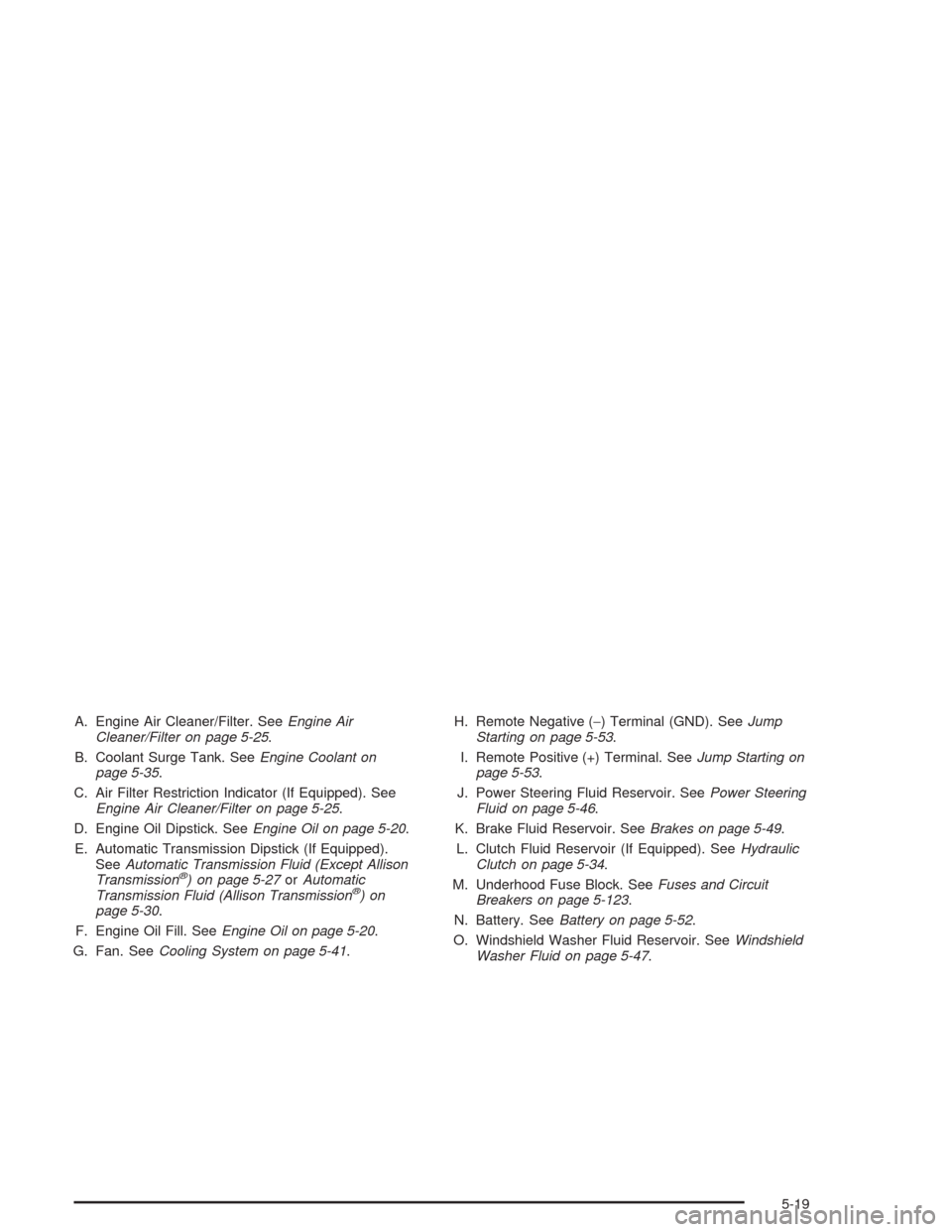
A. Engine Air Cleaner/Filter. SeeEngine Air
Cleaner/Filter on page 5-25.
B. Coolant Surge Tank. SeeEngine Coolant on
page 5-35.
C. Air Filter Restriction Indicator (If Equipped). See
Engine Air Cleaner/Filter on page 5-25.
D. Engine Oil Dipstick. SeeEngine Oil on page 5-20.
E. Automatic Transmission Dipstick (If Equipped).
SeeAutomatic Transmission Fluid (Except Allison
Transmission
®) on page 5-27orAutomatic
Transmission Fluid (Allison Transmission®)on
page 5-30.
F. Engine Oil Fill. SeeEngine Oil on page 5-20.
G. Fan. SeeCooling System on page 5-41.H. Remote Negative (−) Terminal (GND). SeeJump
Starting on page 5-53.
I. Remote Positive (+) Terminal. SeeJump Starting on
page 5-53.
J. Power Steering Fluid Reservoir. SeePower Steering
Fluid on page 5-46.
K. Brake Fluid Reservoir. SeeBrakes on page 5-49.
L. Clutch Fluid Reservoir (If Equipped). SeeHydraulic
Clutch on page 5-34.
M. Underhood Fuse Block. SeeFuses and Circuit
Breakers on page 5-123.
N. Battery. SeeBattery on page 5-52.
O. Windshield Washer Fluid Reservoir. SeeWindshield
Washer Fluid on page 5-47.
5-19
Page 449 of 584
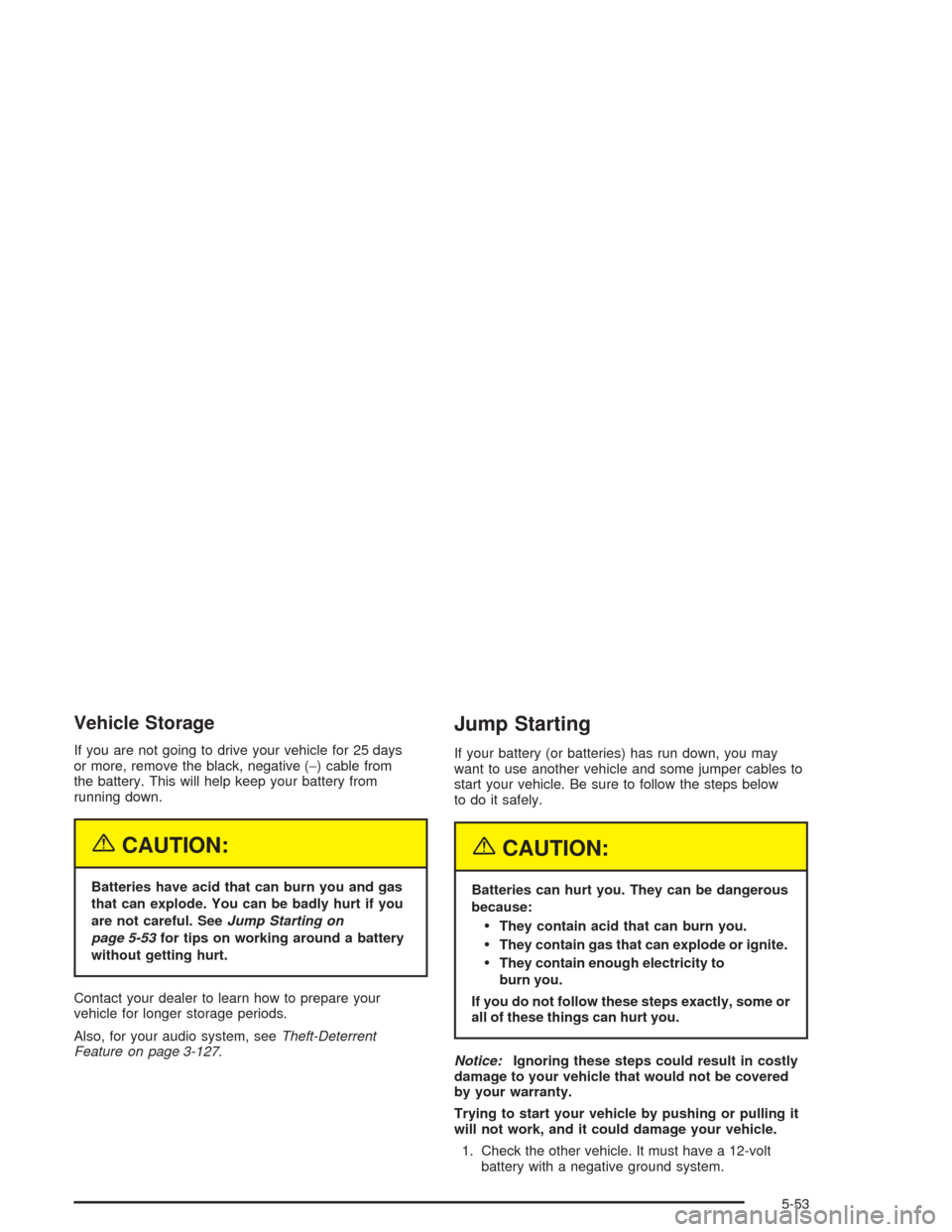
Vehicle Storage
If you are not going to drive your vehicle for 25 days
or more, remove the black, negative (−) cable from
the battery. This will help keep your battery from
running down.
{CAUTION:
Batteries have acid that can burn you and gas
that can explode. You can be badly hurt if you
are not careful. SeeJump Starting on
page 5-53for tips on working around a battery
without getting hurt.
Contact your dealer to learn how to prepare your
vehicle for longer storage periods.
Also, for your audio system, seeTheft-Deterrent
Feature on page 3-127.
Jump Starting
If your battery (or batteries) has run down, you may
want to use another vehicle and some jumper cables to
start your vehicle. Be sure to follow the steps below
to do it safely.
{CAUTION:
Batteries can hurt you. They can be dangerous
because:
They contain acid that can burn you.
They contain gas that can explode or ignite.
They contain enough electricity to
burn you.
If you do not follow these steps exactly, some or
all of these things can hurt you.
Notice:Ignoring these steps could result in costly
damage to your vehicle that would not be covered
by your warranty.
Trying to start your vehicle by pushing or pulling it
will not work, and it could damage your vehicle.
1. Check the other vehicle. It must have a 12-volt
battery with a negative ground system.
5-53
Page 450 of 584
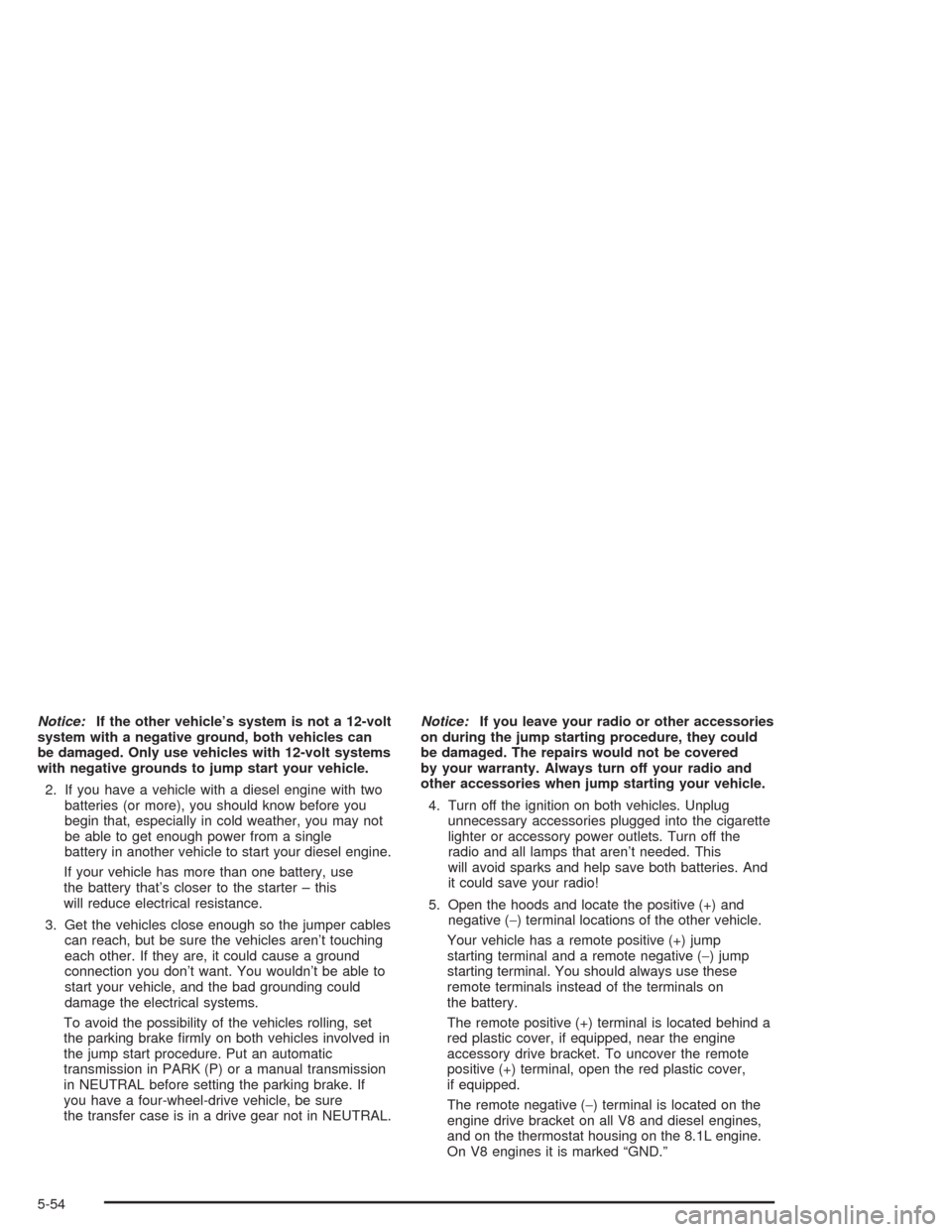
Notice:If the other vehicle’s system is not a 12-volt
system with a negative ground, both vehicles can
be damaged. Only use vehicles with 12-volt systems
with negative grounds to jump start your vehicle.
2. If you have a vehicle with a diesel engine with two
batteries (or more), you should know before you
begin that, especially in cold weather, you may not
be able to get enough power from a single
battery in another vehicle to start your diesel engine.
If your vehicle has more than one battery, use
the battery that’s closer to the starter – this
will reduce electrical resistance.
3. Get the vehicles close enough so the jumper cables
can reach, but be sure the vehicles aren’t touching
each other. If they are, it could cause a ground
connection you don’t want. You wouldn’t be able to
start your vehicle, and the bad grounding could
damage the electrical systems.
To avoid the possibility of the vehicles rolling, set
the parking brake �rmly on both vehicles involved in
the jump start procedure. Put an automatic
transmission in PARK (P) or a manual transmission
in NEUTRAL before setting the parking brake. If
you have a four-wheel-drive vehicle, be sure
the transfer case is in a drive gear not in NEUTRAL.Notice:If you leave your radio or other accessories
on during the jump starting procedure, they could
be damaged. The repairs would not be covered
by your warranty. Always turn off your radio and
other accessories when jump starting your vehicle.
4. Turn off the ignition on both vehicles. Unplug
unnecessary accessories plugged into the cigarette
lighter or accessory power outlets. Turn off the
radio and all lamps that aren’t needed. This
will avoid sparks and help save both batteries. And
it could save your radio!
5. Open the hoods and locate the positive (+) and
negative (−) terminal locations of the other vehicle.
Your vehicle has a remote positive (+) jump
starting terminal and a remote negative (−) jump
starting terminal. You should always use these
remote terminals instead of the terminals on
the battery.
The remote positive (+) terminal is located behind a
red plastic cover, if equipped, near the engine
accessory drive bracket. To uncover the remote
positive (+) terminal, open the red plastic cover,
if equipped.
The remote negative (−) terminal is located on the
engine drive bracket on all V8 and diesel engines,
and on the thermostat housing on the 8.1L engine.
On V8 engines it is marked “GND.”
5-54
Page 560 of 584
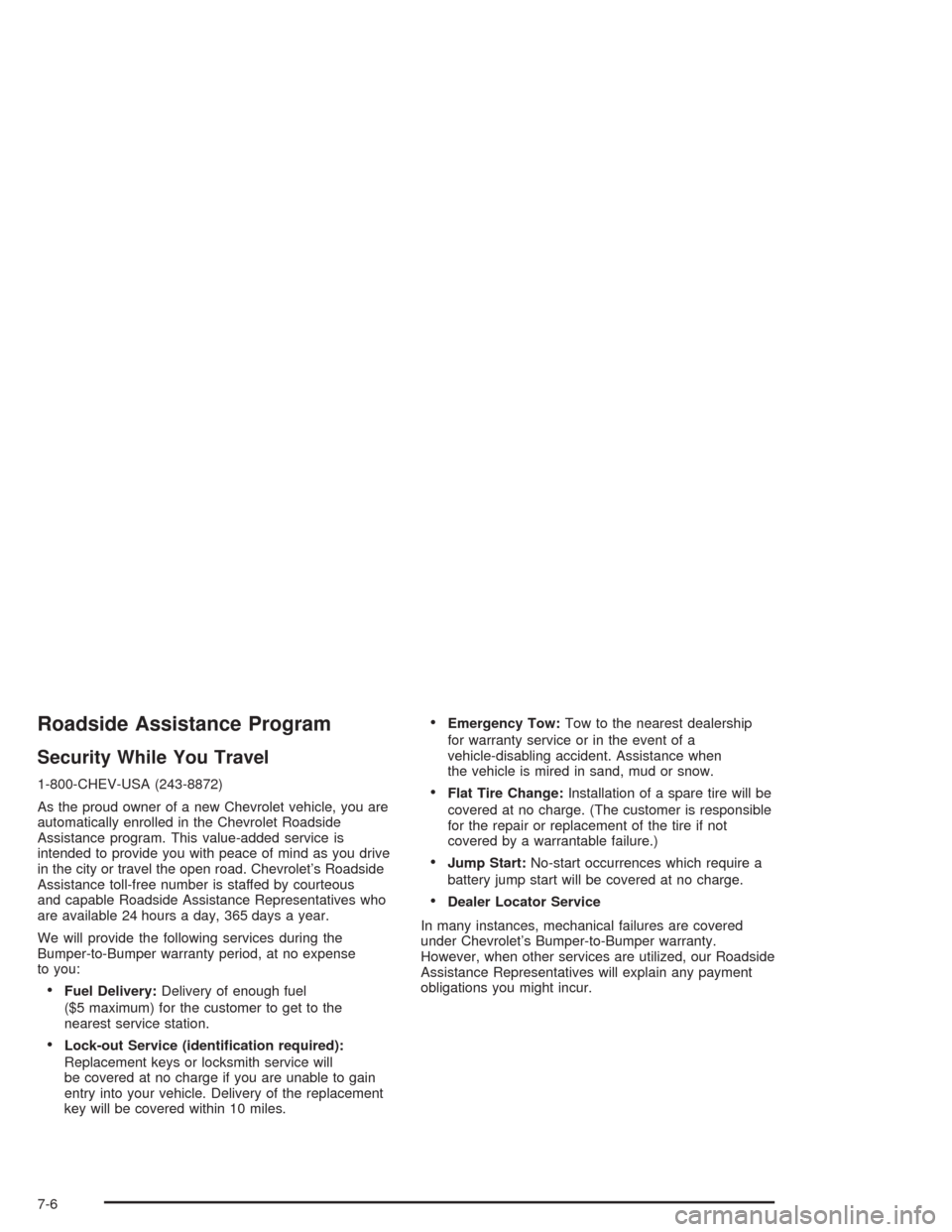
Roadside Assistance Program
Security While You Travel
1-800-CHEV-USA (243-8872)
As the proud owner of a new Chevrolet vehicle, you are
automatically enrolled in the Chevrolet Roadside
Assistance program. This value-added service is
intended to provide you with peace of mind as you drive
in the city or travel the open road. Chevrolet’s Roadside
Assistance toll-free number is staffed by courteous
and capable Roadside Assistance Representatives who
are available 24 hours a day, 365 days a year.
We will provide the following services during the
Bumper-to-Bumper warranty period, at no expense
to you:
Fuel Delivery:Delivery of enough fuel
($5 maximum) for the customer to get to the
nearest service station.
Lock-out Service (identi�cation required):
Replacement keys or locksmith service will
be covered at no charge if you are unable to gain
entry into your vehicle. Delivery of the replacement
key will be covered within 10 miles.
Emergency Tow:Tow to the nearest dealership
for warranty service or in the event of a
vehicle-disabling accident. Assistance when
the vehicle is mired in sand, mud or snow.
Flat Tire Change:Installation of a spare tire will be
covered at no charge. (The customer is responsible
for the repair or replacement of the tire if not
covered by a warrantable failure.)
Jump Start:No-start occurrences which require a
battery jump start will be covered at no charge.
Dealer Locator Service
In many instances, mechanical failures are covered
under Chevrolet’s Bumper-to-Bumper warranty.
However, when other services are utilized, our Roadside
Assistance Representatives will explain any payment
obligations you might incur.
7-6
Page 575 of 584
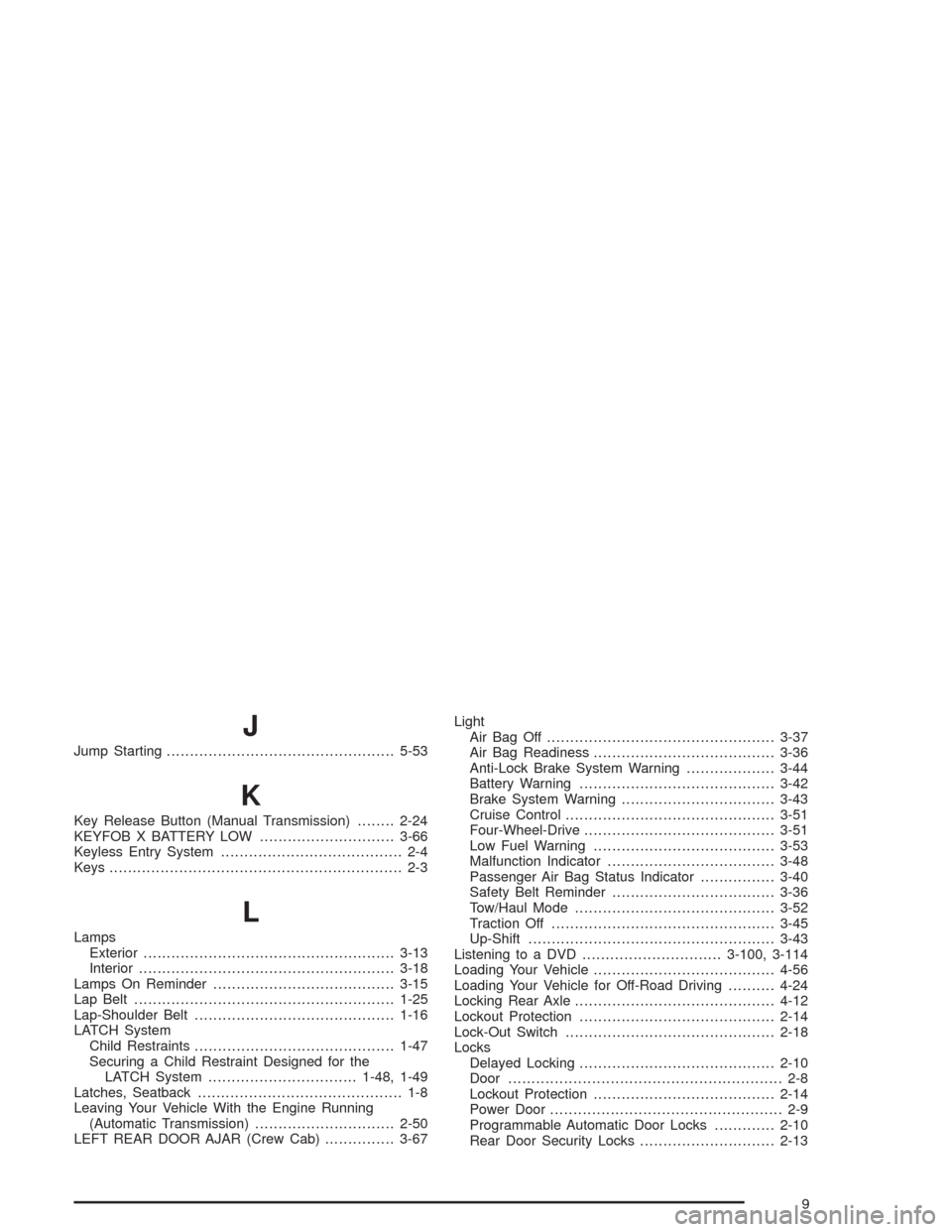
J
Jump Starting.................................................5-53
K
Key Release Button (Manual Transmission)........2-24
KEYFOB X BATTERY LOW.............................3-66
Keyless Entry System....................................... 2-4
Keys............................................................... 2-3
L
Lamps
Exterior......................................................3-13
Interior.......................................................3-18
Lamps On Reminder.......................................3-15
Lap Belt........................................................1-25
Lap-Shoulder Belt...........................................1-16
LATCH System
Child Restraints...........................................1-47
Securing a Child Restraint Designed for the
LATCH System................................1-48, 1-49
Latches, Seatback............................................ 1-8
Leaving Your Vehicle With the Engine Running
(Automatic Transmission)..............................2-50
LEFT REAR DOOR AJAR (Crew Cab)...............3-67Light
Air Bag Off .................................................3-37
Air Bag Readiness.......................................3-36
Anti-Lock Brake System Warning...................3-44
Battery Warning..........................................3-42
Brake System Warning.................................3-43
Cruise Control.............................................3-51
Four-Wheel-Drive.........................................3-51
Low Fuel Warning.......................................3-53
Malfunction Indicator....................................3-48
Passenger Air Bag Status Indicator................3-40
Safety Belt Reminder...................................3-36
Tow/Haul Mode...........................................3-52
Traction Off................................................3-45
Up-Shift.....................................................3-43
Listening to a DVD..............................3-100, 3-114
Loading Your Vehicle.......................................4-56
Loading Your Vehicle for Off-Road Driving..........4-24
Locking Rear Axle...........................................4-12
Lockout Protection..........................................2-14
Lock-Out Switch.............................................2-18
Locks
Delayed Locking..........................................2-10
Door........................................................... 2-8
Lockout Protection.......................................2-14
Power Door.................................................. 2-9
Programmable Automatic Door Locks.............2-10
Rear Door Security Locks.............................2-13
9